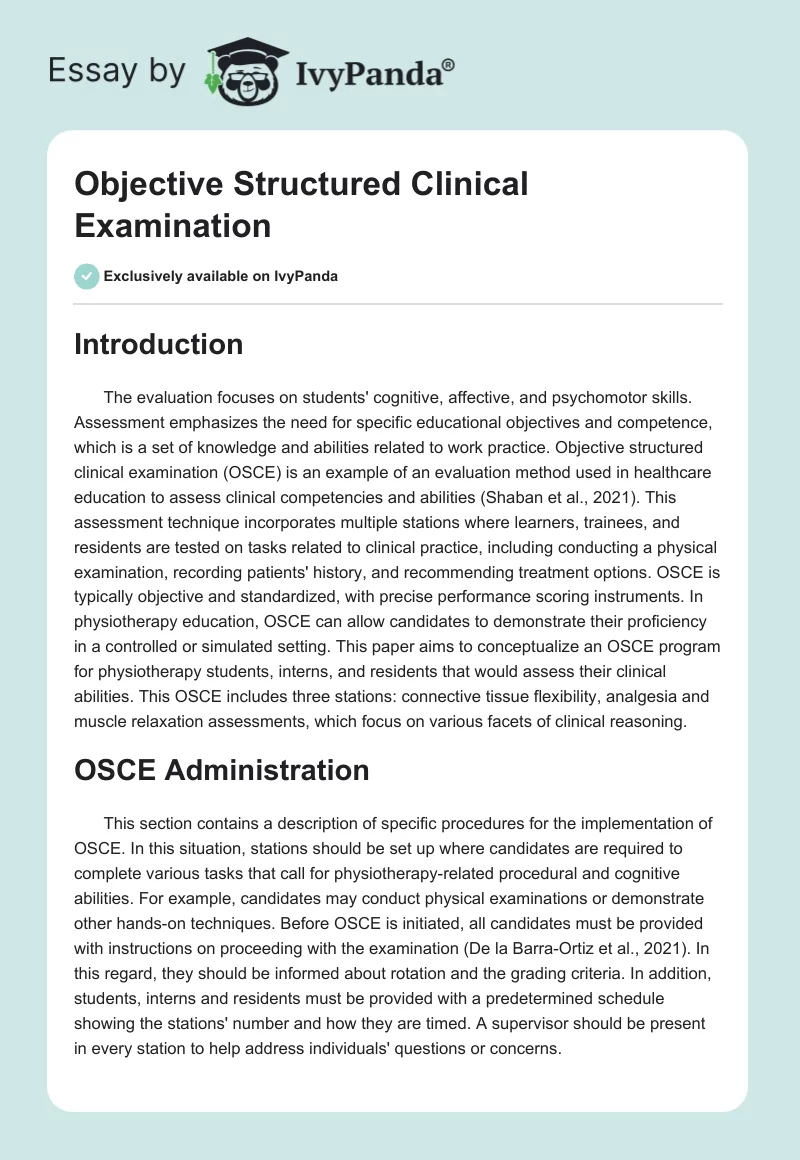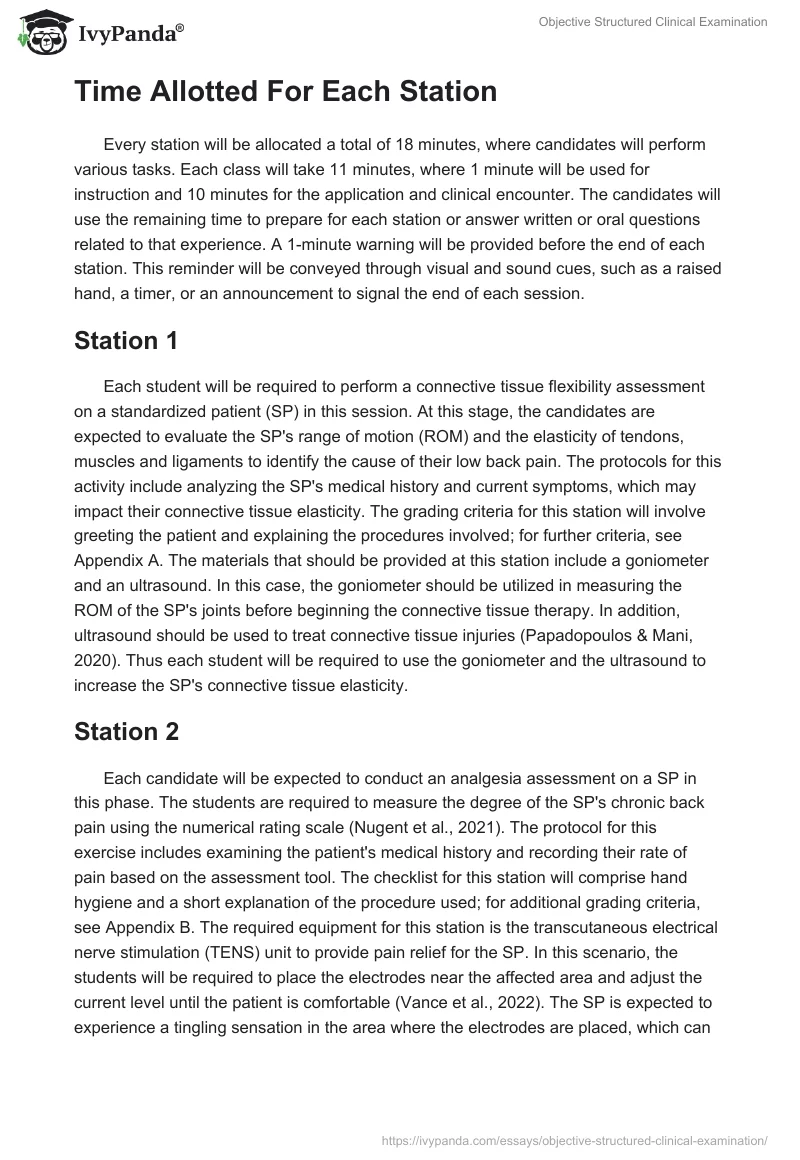Introduction
The evaluation focuses on students’ cognitive, affective, and psychomotor skills. Assessment emphasizes the need for specific educational objectives, competence, knowledge, and abilities related to work practice. Objective structured clinical examination (OSCE) is an example of an evaluation method used in healthcare education to assess clinical competencies and abilities (Shaban et al., 2021).
This assessment technique incorporates multiple stations where learners, trainees, and residents are tested on tasks related to clinical practice, including conducting a physical examination, recording patients’ history, and recommending treatment options. OSCE is typically objective and standardized, with precise performance scoring instruments. In physiotherapy education, OSCE can allow candidates to demonstrate their proficiency in a controlled or simulated setting. This paper aims to conceptualize an OSCE program for physiotherapy students, interns, and residents that would assess their clinical abilities. This OSCE includes three stations: connective tissue flexibility, analgesia and muscle relaxation assessments, which focus on various facets of clinical reasoning.
OSCE Administration
This section contains a description of specific procedures for the implementation of OSCE. In this situation, stations should be set up where candidates are required to complete various tasks that call for physiotherapy-related procedural and cognitive abilities. For example, candidates may conduct physical examinations or demonstrate other hands-on techniques. Before OSCE is initiated, all candidates must be provided with instructions on proceeding with the examination (De la Barra-Ortiz et al., 2021). In this regard, they should be informed about rotation and the grading criteria. In addition, students, interns and residents must be provided with a predetermined schedule showing the stations’ number and how they are timed. A supervisor should be present in every station to help address individuals’ questions or concerns.
Time Allotted For Each Station
Every station will be allocated a total of 18 minutes, where candidates will perform various tasks. Each class will take 11 minutes, where 1 minute will be used for instruction and 10 minutes for the application and clinical encounter. The candidates will use the remaining time to prepare for each station or answer written or oral questions related to that experience. A 1-minute warning will be provided before the end of each station. This reminder will be conveyed through visual and sound cues, such as a raised hand, a timer, or an announcement to signal the end of each session.
Station 1
Each student will be required to perform a connective tissue flexibility assessment on a standardized patient (SP) in this session. At this stage, the candidates are expected to evaluate the SP’s range of motion (ROM) and the elasticity of tendons, muscles and ligaments to identify the cause of their low back pain. The protocols for this activity include analyzing the SP’s medical history and current symptoms, which may impact their connective tissue elasticity. The grading criteria for this station will involve greeting the patient and explaining the procedures involved; for further criteria, see Appendix A. The materials that should be provided at this station include a goniometer and an ultrasound. In this case, the goniometer should be utilized in measuring the ROM of the SP’s joints before beginning the connective tissue therapy. In addition, ultrasound should be used to treat connective tissue injuries (Papadopoulos & Mani, 2020). Thus each student will be required to use the goniometer and the ultrasound to increase the SP’s connective tissue elasticity.
Station 2
Each candidate will be expected to conduct an analgesia assessment on a SP in this phase. The students are required to measure the degree of the SP’s chronic back pain using the numerical rating scale (Nugent et al., 2021). The protocol for this exercise includes examining the patient’s medical history and recording their rate of pain based on the assessment tool. The checklist for this station will comprise hand hygiene and a short explanation of the procedure used; for additional grading criteria, see Appendix B. The required equipment for this station is the transcutaneous electrical nerve stimulation (TENS) unit to provide pain relief for the SP. In this scenario, the students will be required to place the electrodes near the affected area and adjust the current level until the patient is comfortable (Vance et al., 2022). The SP is expected to experience a tingling sensation in the area where the electrodes are placed, which can aid in numbing the pain. Thus, for this assessment, each candidate will need to demonstrate their capability of using TENS to alleviate the patient’s pain.
Station 3
In this station, each student is expected to conduct a muscle relaxation assessment on a SP. This exercise will require the interns to check for short-wave diathermy (SWD) contraindications before performing the muscle relaxation procedure on the SP’s neck. The protocol will necessitate the candidates to perform an extensive medical history of the SP and enquire about the conditions that may be contraindicated for SWD, such as metal implants, pregnancy and pacemakers (Masiero et al., 2019). Additionally, the students will be required to perform a thorough physical exam to check for swelling in the affected area and to review the SP’s medication use to determine if any contraindications to SWD exist. The grading list for this phase will involve assessing for any contraindications for SWD; for an additional checklist, see Appendix C. The necessary material for this station is the biofeedback machine to assess the muscle tensions if the SP’s condition adversely reacts to SWD (Noe, 2020). The candidate will be required to attach the biofeedback machine sensors to the patient’s neck muscles to detect muscle tension levels and perform a progressive muscle relaxation procedure.
Conclusion
This OSCE exercise is designed to evaluate students, interns, and residents’ physical therapy clinical reasoning skills. The OSCE includes three stations focusing on SP assessment, namely connective tissue flexibility, analgesia and muscle relaxation, which focus on various facets of clinical reasoning. Each station is allocated 18 minutes, and students will receive a 1-minute warning before the end of each station. The grading criteria for each station will be a checklist corresponding to the ones provided to every participant. The OSCE evaluation will require students to demonstrate their knowledge and skills using a goniometer, ultrasound, SWD or biofeedback machine techniques to remedy various musculoskeletal conditions. In this case, the examiners’ grading format may include the candidate’s ability to select appropriate treatment parameters, correctly position and operate the instruments, and communicate effectively with SP. The students will also be assessed based on their ability to monitor SP’s response to the treatment and modify the treatment plan as needed. The OSCE will allow candidates to demonstrate their competencies in a controlled and simulated environment, enhancing their clinical reasoning skills.
References
De la Barra-Ortiz, H. A., Gómez-Miranda, L. A., & De la Fuente-Astroza, J. I. (2021). Objective structured clinical examination (OSCE) to assess the clinical skills of physical therapy students when using physical agents. Revista De La Facultad De Medicina, 69(3), 1-9. Web.
Masiero, S., Pignataro, A., Piran, G., Duso, M., Mimche, P., Ermani, M., & Del Felice, A. (2019). Short-wave diathermy in the clinical management of musculoskeletal disorders: A pilot observational study. International Journal of Biometeorology, 64, 981–988. Web.
Noe, C. D. (2020). Pain management for clinicians: A guide to assessment and treatment. Springer.
Nugent, S. M., Lovejoy, T. I., Shull, S., Dobscha, S. K., & Morasco, B. J. (2021). Associations of pain numeric rating scale scores collected during usual care with research administered patient reported pain outcomes. Pain Medicine, 22(10), 2235–2241. Web.
Papadopoulos, E. S., & Mani, R. (2020). The role of ultrasound therapy in the management of musculoskeletal soft tissue pain. The International Journal of Lower Extremity Wounds, 19(4), 350–358. Web.
Vance, C. G., Dailey, D. L., Chimenti, R. L., Van Gorp, B. J., Crofford, L. J., & Sluka, K. A. (2022). Using tens for pain control: Update on the state of the evidence. Medicina, 58(1332), 1-27. Web.
Appendix A
Candidate’s Instructions: A SP is presented to you complaining of low back pain. In the next 10 minutes, use ultrasound and goniometer as treatment modalities for muscle strains, tendinitis, or bursitis to make connective tissue more flexible.
Examiner’s Grading Criteria: Fill in the bubble for each item accomplished satisfactorily
Appendix B
Candidate’s Instructions: A SP is presented to you complaining of chronic back pain. In the next 10 minutes, use the TENS unit to relieve the SP’s pain.
Examiner’s Grading Criteria: Indicate the score based on the candidate’s performance
Appendix C
Candidate’s Instructions: A SP is presented to you complaining of tense muscles of the neck. In the next 10 minutes, use the SWD technique and biofeedback machine to remedy various musculoskeletal conditions.


